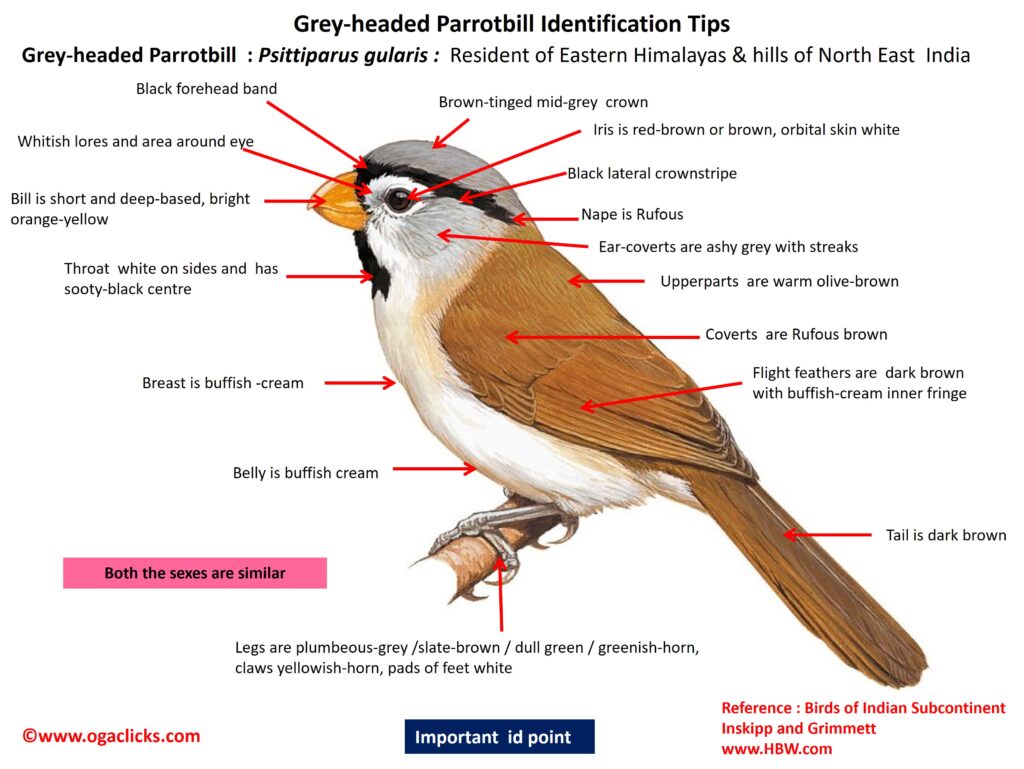
Grey-headed Parrotbill Psittiparus gularis
Etymology:
- Psittiparus : ALtin word psittacus – parrot; parus – tit
- Gularis : Latin word gula– throat
Vernacular Names : Cachar: Dao mougasha gophu, Lepcha: Chongto phep-pho, Naga: Indo-rui gahabale
Sub Species :
- Nominate- Himalayas and foothills from N India (Sikkim and extreme North West Bengal) East through Bhutan to W Arunachal Pradesh (North East India)
- g. transfluvialis – Central & East Arunachal Pradesh (East from Dafla Hills), South through hills of North East India (except Meghalaya) to Mizoram and Manipur { more buffish below}
Distribution :
- Nominate- Himalayas and foothills from N India (Sikkim and extreme North West Bengal) East through Bhutan to W Arunachal Pradesh (North East India)
- g. transfluvialis – Central & East Arunachal Pradesh (East from Dafla Hills), South through hills of North East India (except Meghalaya) to Mizoram and Manipur.
Description : It has a size of 15·5–18·5 cm; wt. of male 27–30 g, wt.of female 30·5–34 g. The nominate race has faintly brown-tinged mid-grey crown and nape, black forehead and black lateral crownstripe, latter continuing as long supercilium from behind eye, whitish lores (mixed with grey) and area around eye, and pale ash-grey head side with whiter cheek. The upperparts are rufous-brown; wing feathers are dark brown with inner webs still darker, primaries and secondaries are with buffish-cream inner fringe, upperwing-coverts and outer fringes of remiges are similar in colour to upperparts, slightly brighter on outer fringes of tertials to primaries, outer fringes of primaries slightly paler still towards tips. The tail is dark brown, narrowly fringed along outer webs with an olive-tinged shade of upperpart colour. The throat is white at side and with sooty-black centre , chin slightly greyer, underparts are buffish-cream. The iris is red-brown or brown, orbital skin is white; bill is short and deep-based, bright orange-yellow. The legs are plumbeous-grey or slate-brown to dull green or greenish-horn, claws are yellowish-horn, pads of feet are white. Both the sexes are alike. The juvenile has much brighter rufescent upperside than adult, less pure greyish crown, less well-defined blackish throat centre, buffier-tinged underparts, narrower bill, rounded first primary, and narrower tail feathers. Race transfluvialis tends to be more buffish below than nominate; rasus is smaller, and lacks black on throat; fokiensis is larger and heavier than nominate, with grey of head (particularly head side) more slaty, underparts slightly whiter; laotianus is only slightly larger than nominate, with plumage similar to previous but grey of crown and head side slightly paler, underside a little paler; hainanus is slightly smaller than nominate, has strong rufous-chestnut wash on upperside, and head and underpart coloration similar to last.
Habitat: It is found in broadleaf evergreen forest, secondary growth, scrub bordering forest, also bamboo, grass and scrub in pine forest. It is found at 610–2100 m.
Food habits: It eats vegetable matter, including chestnuts, buds, seeds; also insects and their larvae. It is found in parties mostly of 6–8 individuals. It regularly joins babblers and smaller birds in bird waves. It is more arboreal than other parrotbills, often feeding in treetops, also descending to undergrowth, and occasionally to ground itself. It picks up buds and carries them to a convenient twig, where they are held under the feet and picked to pieces in manner of a tit.
Breeding habits: They breed in Feb–Jul. The nest is a beautiful, very neat, compact cup-shaped structure, sometimes with broad, bulging sides, made from grasses, strips of bamboo leaves , leaf skeletons and similar material, plastered with cobwebs and spider cocoons, wool and other soft material, lined with fine grass stems, rootlets, shreds of grass bark situated in sapling, forked branch of medium-sized tree, reeds, tall grass, bamboo clump or bush. They lay a clutch of 2–4 eggs